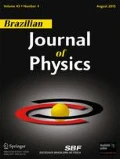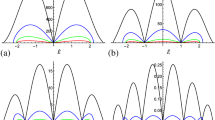Abstract
Numerical simulations of the two-point eigenvalue correlation and cluster functions of the Gaussian unitary ensemble (GUE) are carried out directly from their definitions in terms of deltas functions. The simulations are compared with analytical results which follow from three analytical formulas for the two-point GUE cluster function: (i) Wigner’s exact formula in terms of Hermite polynomials, (ii) Brezin and Zee’s approximate formula which is valid for points with small enough separations and (iii) French, Mello and Pandey’s approximate formula which is valid on average for points with large enough separations. It is found that the oscillations present in formulas (i) and (ii) are reproduced by the numerical simulations if the width of the function used to represent the delta function is small enough and that the non-oscillating behaviour of formula (iii) is approached as the width is increased.








Similar content being viewed by others
References
J. Wishart, . Biometrika. 20A, 32 (1928)
E.P. Wigner, in . Proceedings of the fourth canadian mathematical congress, Banff, 1957 (Univ. of Toronto Press, Toronto), pp 174–184, ed. by M.S. Macphail. Reprinted in [3]. (1959)
C.E. Porter. Statistical theories of spectra: fluctuations (Academic Press, New York, 1965)
T.A. Brody, J. Flores, J.B. French, P.A. Mello, A. Pandey, S.S.M. Wong, . Rev. Mod. Phys. 53, 385–479 (1981)
G.E. Mitchell, A. Richter, H.A. Weidenmüller, . Rev. Mod. Phys. 82, 2845 (2010)
H.A. Weidenmüller, G.E. Mitchell, . Rev. Mod. Phys. 81, 539 (2009)
A.J. Sargeant, M.S. Hussein, A.N. Wilson, in . Nuclei and mesoscopic physics: Workshop on nuclei and mesoscopic physics; WNMP 2004, AIP Conf. Proc., 777, pp 46–54, ed. by V. Zelevinsky, (2005)
M.S. Hussein, B.V. Carlson, A.K. Kerman, . Acta Phys. Pol. B. 47, 391 (2016)
O. Bohigas, M.-J. Giannoni, in . Mathematical and computational methods in nuclear physics, Lecture notes in physics, 209 (Springer), pp 1–99, ed. by J.S. Dehesa, J.M.G. Gomez, A. Polls, (1984)
O. Bohigas, in . Les houches 1989 session LII chaos and quantum physics (North Holland, Amsteram), pp 87–199, ed. by M.-J. Giannoni, A. Voros, J. Zinn-Justin, (1991)
M.A. Stephanov, J.J.M. Verbaarschot, T. Wettig, in . Wiley encyclopedia of electrical and electronics engineering (Wiley), ed. by J.G. Webster, (1999)
C.W.J. Beenakker, . Nucl. Phys. B. 422, 515 (1994)
M.S. Hussein, J.G.G.S. Ramos, in Universal fluctuations and coherence lengths in chaotic mesoscopic systems and nuclei. Nuclei and mesoscopic physics 2017, AIP Conf. Proc., 1912, p 020007, ed. by P. Danielewicz, V. Zelevinsky, (2017)
J. Ambjørn, Y.M. Makeenko, . Mod. Phys. Lett. A. 5, 1753 (1990)
A. Edelman, B.D. Sutton, Y. Wang, in Random matrix theory, numerical computation and applications. Modern aspects of random matrix theory, proceedings of symposia in applied mathematics (American Mathematical Society), 72, pp 53–82, ed. by V.H. Vu, (2014)
B. Hayes, . Am. Sci. 91, 296 (2003)
P.J. Forrester, A. Mays, . Proc. R. Soc. Lond. A. 471, 20150436 (2015)
M. Wolf, . Rep. Prog. Phys. 83, 036001 (2020)
G. Ergün, in . Encyclopedia of complexity and systems science (Springer, N.Y.), pp 7505–7520, ed. by R.A. Meyers, (2009)
F.J. Dyson, . J. Math. Phys. 3, 166 (1962)
F.J. Dyson, M.L. Mehta, . J. Math. Phys. 4, 701 (1963)
G. Livan, M. Novaes, P. Vivo. Introduction to random matrices: theory and practice (Springer, Berlin, 2018)
E.P. Wigner, Distribution laws for the roots of a random Hermitean matrix. Published in [3]. (1962)
M.L. Mehta, F.J. Dyson, . J. Math. Phys. 4, 713 (1963)
B.V. Bronk, . J. Math. Phys. 5, 215 (1964)
M.L. Mehta. Random matrices and the statistical theory of energy levels (Academic Press, New York, 1967)
J.M.G. Gómez, R.A. Molina, A. Relaño, J. Retamosa, . Phys. Rev. E. 66, 036209 (2002)
A.J. Sargeant, M.S. Hussein, M.P. Pato, M. Ueda, . Phys. Rev. C. 61, 011302 (2000)
H. Feshbach. Theoretical nuclear physics: Nuclear reactions (Wiley, New York, 1992)
H. Pishro-Nik, Introduction to probability, statistics, and random processes, (Kappa Research LLC) . Available at https://www.probabilitycourse.com (2014)
Y.V. Fyodorov, in Recent perspectives in random matrix theory and number theory, London mathematical society lecture note series (Cambridge University Press), pp 31–78, ed. by F. Mezzadri, N.C. Snaith, (2005)
E. Brézin, A. Zee, . Nucl. Phys. B. 402, 613 (1993)
E. Brézin, . Physica A. 221, 372 (1995)
J.B. French, P.A. Mello, A. Pandey, . Ann. Phys. 113, 277 (1978)
A. Pandey, . Ann. Phys. 134, 110 (1981)
A.M. Khorunzhy, B.A. Khoruzhenko, L.A. Pastur, . J. Math. Phys. 37, 5033 (1996)
A.M.S. Macêdo, . Phys. Rev. E. 55, 1457 (1997)
Y. He, A. Knowles, . Probab. Theory Relat. Fields. 177, 147 (2020)
T.S. Kobayakawa, Y. Hatsugai, M. Kohmoto, A. Zee, . Phys. Rev. E. 51, 5365 (1995)
A.C. Bertuola, J.X. de Carvalho, M.S. Hussein, M.P. Pato, A.J. Sargeant, . Phys. Rev. E. 71, 036117 (2005)
T. Guhr, A. Müller-Groeling, H.A. Weidenmüller, . Phys. Rep. 299, 189 (1998)
Acknowledgments
I would like to acknowledge happy collaborations with Mahir Saleh Hussein and Mauricio Porto Pato which involved random matrices in nuclear physics and were the precursor to this work.
Author information
Authors and Affiliations
Corresponding author
Additional information
Publisher’s Note
Springer Nature remains neutral with regard to jurisdictional claims in published maps and institutional affiliations.
Appendix
Appendix
In this appendix we offer some considerations on the coding of the ensemble average in (14) for the two-point correlation function. Let us denote the ith eigenvalue of the kth realisation of the ensemble by Eik and define \(N\times k_{\max \limits }\) matrices X and Y whose elements are δ(Ex − Eik) and δ(Ey − Eik) respectively. Then the two-point correlation function R of energies Ex and Ey may be conveniently coded in Octave or MATLAB by
where the N × N matrix D is the outer product of X and Y' (the transpose of Y) and sum(D(:)) is the grand sum of its elements.
Rights and permissions
About this article
Cite this article
Sargeant, A.J. Numerical Simulation of GUE Two-Point Correlation and Cluster Functions. Braz J Phys 51, 308–315 (2021). https://doi.org/10.1007/s13538-020-00802-6
Received:
Accepted:
Published:
Issue Date:
DOI: https://doi.org/10.1007/s13538-020-00802-6



